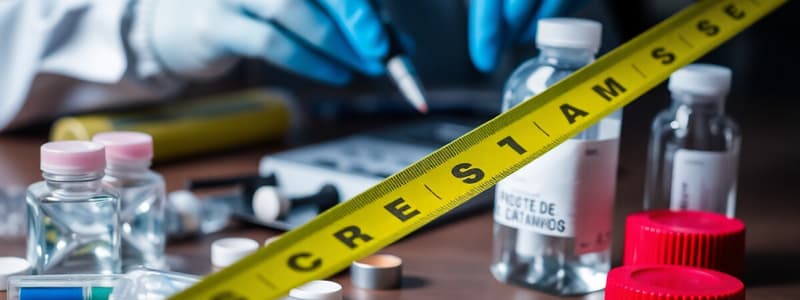Podcast
Questions and Answers
Which of these disciplines is directly involved in the study of skeletal remains?
Which of these disciplines is directly involved in the study of skeletal remains?
- Forensic Anthropology (correct)
- Forensic Pathology
- Forensic Odontology
- Forensic Entomology
What is the primary purpose of forensic audio and video analysis?
What is the primary purpose of forensic audio and video analysis?
- Determining the time of death
- Analyzing digital evidence on computers
- Gathering information relevant to the crime (correct)
- Identifying suspects through voice recognition
Which forensic discipline utilizes insects to estimate the time since death?
Which forensic discipline utilizes insects to estimate the time since death?
- Forensic Entomology (correct)
- Forensic Pathology
- Forensic Anthropology
- Forensic Odontology
Which of the following represents a challenge faced by forensic scientists?
Which of the following represents a challenge faced by forensic scientists?
Which forensic discipline focuses on identifying individuals through their unique dental structures?
Which forensic discipline focuses on identifying individuals through their unique dental structures?
Which of the following is NOT a common type of evidence collected at a crime scene?
Which of the following is NOT a common type of evidence collected at a crime scene?
What is the primary goal of forensic science?
What is the primary goal of forensic science?
What technique is NOT typically used to capture fingerprints?
What technique is NOT typically used to capture fingerprints?
What is the purpose of trajectory analysis in ballistics?
What is the purpose of trajectory analysis in ballistics?
Which of the following is NOT a common type of trace evidence?
Which of the following is NOT a common type of trace evidence?
What kind of information can toxicological analysis provide in a case of suspected poisoning?
What kind of information can toxicological analysis provide in a case of suspected poisoning?
What is the primary focus of document examination?
What is the primary focus of document examination?
What is AFIS used for?
What is AFIS used for?
Flashcards
Forensic Pathology
Forensic Pathology
Examination of cause and manner of death through autopsy.
Forensic Odontology
Forensic Odontology
Identification of individuals via unique dental structures.
Forensic Entomology
Forensic Entomology
Study of insects to determine time of death.
Digital Forensics
Digital Forensics
Signup and view all the flashcards
Chain of Custody
Chain of Custody
Signup and view all the flashcards
Forensic Science
Forensic Science
Signup and view all the flashcards
Crime Scene Investigation
Crime Scene Investigation
Signup and view all the flashcards
Fingerprint Analysis
Fingerprint Analysis
Signup and view all the flashcards
DNA Analysis
DNA Analysis
Signup and view all the flashcards
Ballistics
Ballistics
Signup and view all the flashcards
Trace Evidence
Trace Evidence
Signup and view all the flashcards
Toxicology
Toxicology
Signup and view all the flashcards
Document Examination
Document Examination
Signup and view all the flashcards
Study Notes
Introduction to Forensic Science
- Forensic science applies scientific methods to legal matters.
- It uses various disciplines to investigate crimes and collect evidence.
- It aims to provide objective and scientifically sound evidence for justice.
Crime Scene Investigation
- Systematic crime scene investigation is essential.
- Initial steps include documenting layout, condition, and securing the area to prevent contamination.
- Evidence collection adheres to protocols to preserve integrity.
- Evidence types include physical traces (fingerprints, blood, fibers), biological samples (DNA), and impressions (footwear, tire marks).
Fingerprint Analysis
- Fingerprints are unique patterns on fingertips, invaluable for identification.
- Techniques include dusting, lifting, and chemical enhancements.
- Automated Fingerprint Identification Systems (AFIS) are used for comparison and searching.
DNA Analysis
- DNA, deoxyribonucleic acid, has unique genetic information for individuals (except identical twins).
- DNA profiling extracts and analyzes DNA from biological samples (blood, saliva, hair).
- DNA evidence establishes or excludes suspects, identifies victims, and traces familial relationships.
Ballistics
- Ballistics studies the motion, behavior, and effects of projectiles (bullets).
- Firearms identification determines the weapon type.
- Trajectory analysis reconstructs a projectile's path.
Trace Evidence
- Trace evidence includes small items (fibers, hairs, glass, paint, soil).
- Analysis links suspects to crime scenes or eliminates them as suspects.
Toxicology
- Toxicological analysis detects drugs or poisons in bodily fluids or tissues.
- Results determine cause and manner of death.
- This is crucial in poisoning or overdose cases.
Document Examination
- Document examination analyzes documents (signatures, handwriting, typewriting).
- It assesses authenticity and determines if a document is genuine or forged.
Pathology
- Forensic pathology examines cause and manner of death via autopsy.
- Pathologists use methods like microscopy to determine injuries and death causes.
Odontology (Forensic Dentistry)
- Forensic odontology identifies individuals via unique dental structures.
- Dental records are compared to skeletal remains or other evidence.
Entomology (Forensic Entomology)
- Forensic entomology studies insects to determine time since death.
- Insect infestation and development stages are key factors.
Audio and Video Analysis
- Forensic audio and video analysis examines audio and video recordings.
- Sounds and images can help establish events and provide detail.
Digital Forensics
- Digital forensics analyzes digital evidence (computers, phones).
- This includes data recovery, image analysis, and network forensics.
Other Forensic Disciplines
- Other disciplines contribute (anthropology, geology, engineering).
Challenges and Limitations
- Maintaining evidence's chain of custody is crucial.
- Forensic evidence can be contaminated, degraded, or misinterpreted.
- Interpreting evidence demands expertise and considering many factors.
- Technological advancements drive ongoing development.
Studying That Suits You
Use AI to generate personalized quizzes and flashcards to suit your learning preferences.



